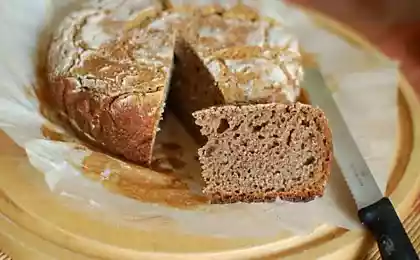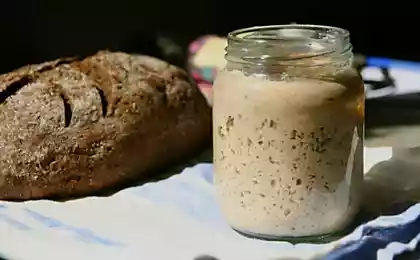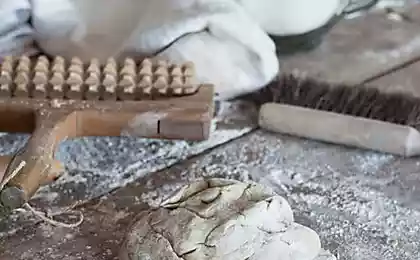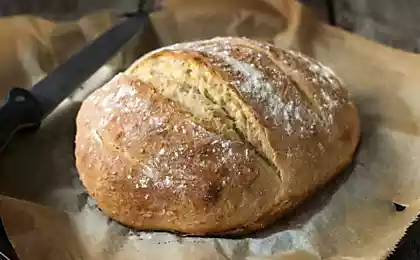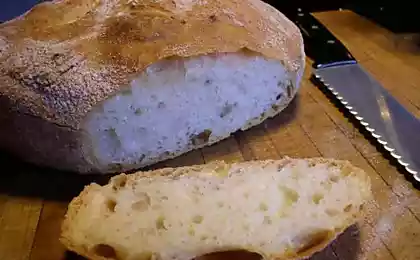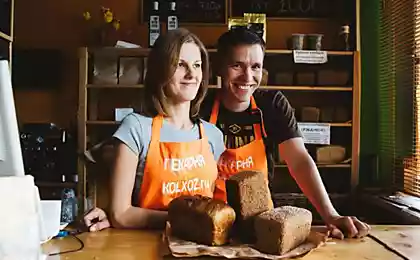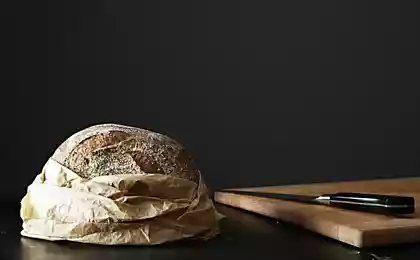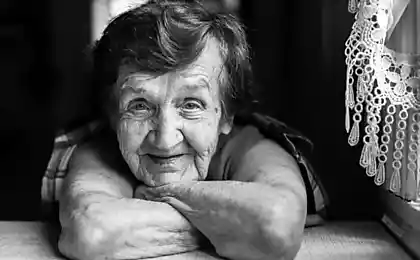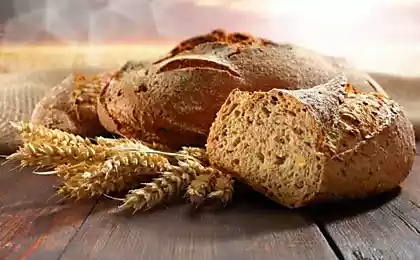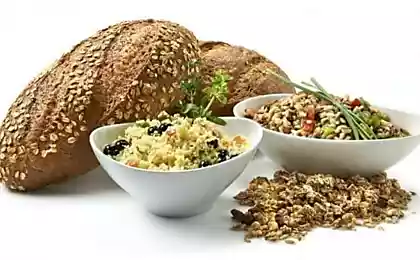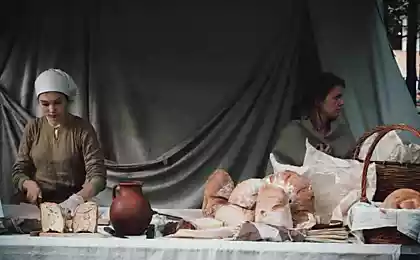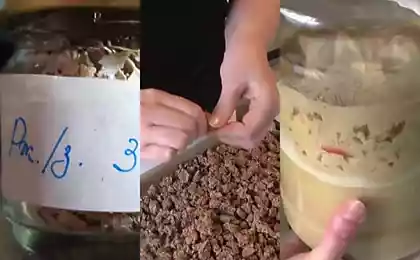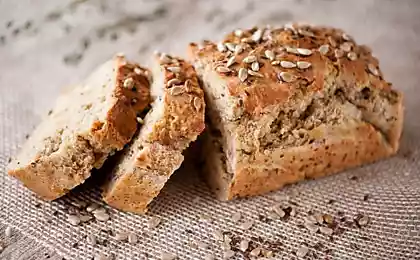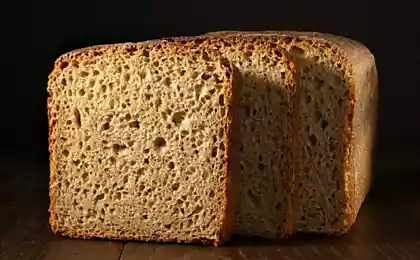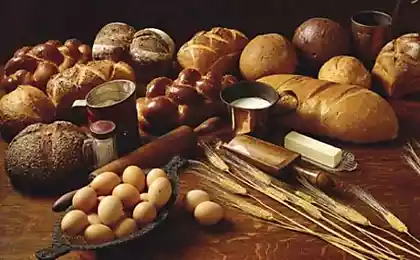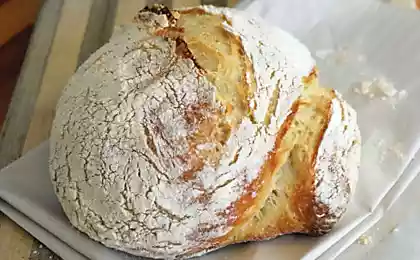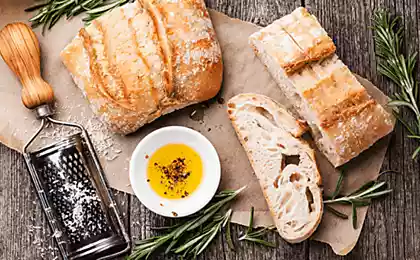736
A simple recipe of fragrant sourdough bread
This is a basic recipe for those who are just at the initial stage of baking bread using sourdough. A win-win and a great result. In my opinion, this bread is the taste balance. For me, as a taster, this is important. And an absolutely perfect crust.
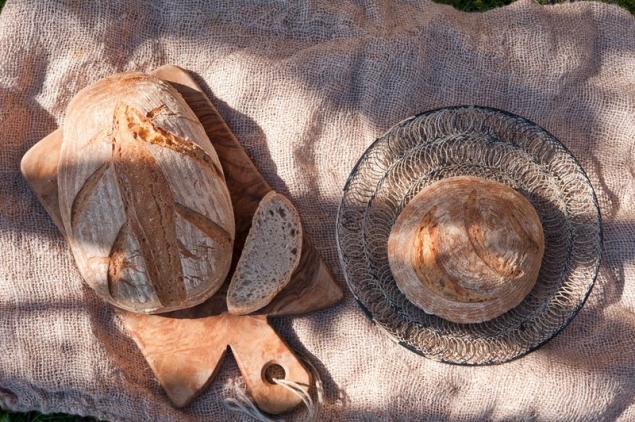
You will need:
for 3 loaves at 550 g each (basic recipe):
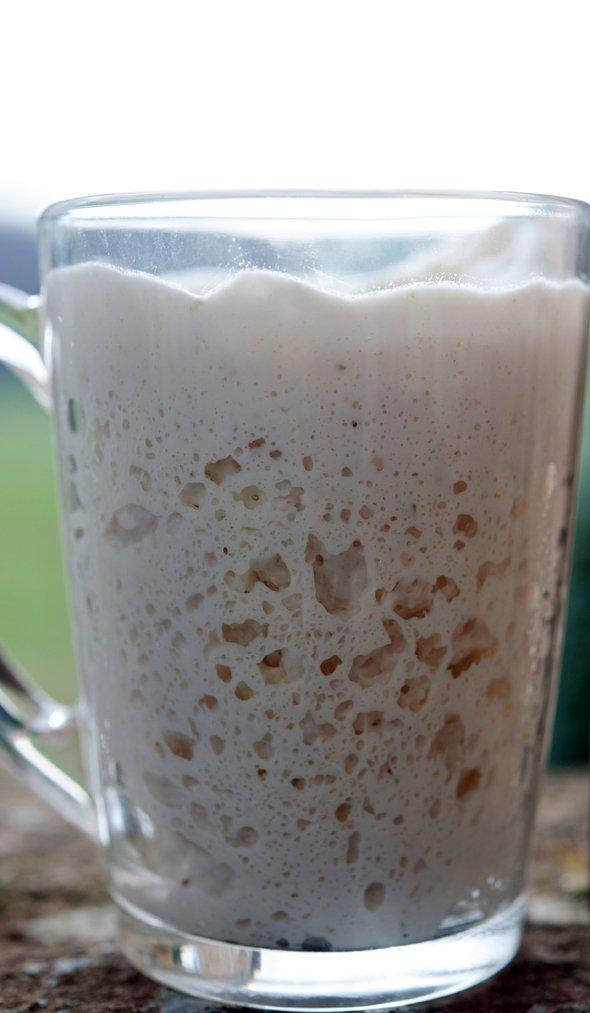
The first feeding
50 g of starter at room temperature
40 g of water (maximum water temperature 35 C)
50 g whole wheat flour
In a bowl put the yeast and add the water. Stir well until a homogeneous mass, add the sifted flour (always her screening, even whole wheat, to avoid lumps in the dough, and that she was saturated with oxygen).
Knead the dough using a wooden spoon or with your hands (as you wish).
Put the dough in a clean bowl, cover it with clingfilm (you can use a measuring Cup) and leave to rise for at room temperature not lower than 22-23 With, until the dough will increase in volume by half (about 5-6 hours).
The second feeding
50 g of the leaven obtained after the first feeding
40 g of water (water temperature about 25 C)
50 g whole wheat flour
In a bowl put the yeast and add the water. Stir well until a homogeneous mass, add the sifted flour.
Knead the dough using a wooden spoon or with your hands (as you wish).
Put the dough in a clean bowl, cover it with cling film (or measuring Cup) and leave to rise for at room temperature not lower than 22-23 With, until the dough will increase in volume twice (about 4 hours).
The third feeding
50 g of the leaven obtained after the second feeding
40 g of water (water temperature about 25 C)
50 g whole wheat flour
In a bowl put the yeast and add the water. Stir well until a homogeneous mass, add the sifted flour.
Knead the dough using a wooden spoon or with your hands (as you wish).
Put the dough in a clean bowl, cover it with cling film (or measuring Cup) and leave to rise for at room temperature not lower than 22-23 With, until the dough will increase in volume twice (approximately 2 hours).
After three feedings, your starter will be strong enough to begin baking bread.
Subsequently, when baking bread, you can instead of flour from soft wheat type 0 to use other types of flour, in the amount of 30-50% and to change the hydration (to increase). Immediately say, that we used 5 types of flour for making this bread.
Keep in mind that the more bread content whole wheat flour, the more water will be required for kneading.
Ideally use a baking stone. But you can also use a regular baking sheet.
Preparation of starter
150 g of flour from soft wheat type 0 (basic recipe)
200 g of water at room temperature of 22-23 C (from main recipe)
70/80 g of the leaven obtained after the third feeding, as described above
First day. Evening, 20.00-21.00
Sift the flour into a separate bowl. In another bowl, put the yeast, pour the water and stir well with a wooden spoon until a homogeneous mass. Add portions of the flour and continue mixing with a wooden spoon. Starter bude sufficiently liquid.
Cover the bowl with the starter with clingfilm and leave to rise for 12 hours at a temperature of 20-21 C.
At higher temperatures the dough grows faster, but not enough will be filled with aromas, that is the bread is not so tasty.
The starter will weigh approximately 400 g.
Kneading dough by mixing the starter with the other ingredients
The second day. Morning 7.00-8.00
On the starter there are a lot of bubbles and a pleasant yeasty aroma. Knead the dough.
750 g of flour from soft wheat type 0 (basic recipe)
100 g whole wheat flour
400 g of water, heated to a temperature of 28-30 C (from main recipe)
18 g of salt
400 g starter
Sift all the flour and divide into two equal parts.
In the bucket combine put the starter, pour in water and stir using the whisk attachment. Using the same attachment, start mixing the dough, portions adding half of the flour.
The second part of the flour add salt and mix. Change in harvester attachment for the whisk attachment hook and continue kneading.
To do this, add portions of the remaining flour (the second half of that mixed with salt).
Continue kneading until a homogeneous, elastic mass, about 15 minutes.
The final dough should have a temperature of 25-26 C.
The first proving
Put the dough obtained in a container (glass is ideal), greased with olive oil cold pressed and wrap well with cling film. Put the dough into the proofing at a temperature of 25-26 C.
Remember that the proofing time depends on many factors: the type of flour, humidity of the flour and the humidity, temperature, hydration, the power of the leaven. Therefore, it is always very approximate. The only thing you can focus is to increase the test.
Therefore, the dough needs to rise twice (about 2.5 hours).
During this proofing get obmenka.The punching is stretching and folding the dough. They make the dough become elastic and rise better during baking.
First obmenka done in 50 minutes.
Turn the dough out onto a work surface lightly sprinkled with flour. Slightly (!) pull one edge of dough and fold it in the middle. Then do the same with the other three edges. That is the principle of the envelope. Salmon ball and put it seam down again to the bowl for further proofing, shook it with cling film.
After 50 minutes, repeat the folding. And wait until the dough has doubled, that is about another 1.5 hours.
The first shaping loaves (boulage)
The ready dough put on a work surface lightly dusted with flour and divide into 3 parts. Form balls and place them on the work surface seam side down.
Pause or rest
Leave the dough to rest on the work surface at room temperature for 30 minutes. Lightly cover it with cling film.
The final shaping of the loaf using baskets
Form the shape of a loaf, given the size of the basket. Pomeroy loaf, gently bend the edges of the dough down well and don't forget to close the seam. Ee lightly sprinkle with flour.
Line a rimmed the bottom of the basket with cling film and then put a wet piece of cloth (thin), the dough was always otavalos slightly damp. Turn the dough seam side up and lightly sprinkle the dough with flour.
More can not touch the dough with your hands, otherwise then it will not rise.
Close the dough with wet cloth and cling film.
Second final proofing
Leave the dough to rise for 1.5-2 hours at a temperature of 24-25 C.
If the oven does not include all three loaves, leave one of them to rise for at a temperature of 12 C. It will be ready for baking after about 3 hours.
How to check if your bread is to baking? Easily tap with your finger in the middle of the dough. If the dough is elastic and will immediately return to its original state, then it is ready. If you will trace from the finger, then you need to wait more. But remember that you should always start the baking before the dough will start to fall off, otherwise, then, in the oven, it is so you won't get up.
Baking bread
Turn the oven (with convection), put it in the middle of the baking sheet or stone on the grill and put down a small bowl filled with boiling water. Preheat the oven to 250 C.
In the oven with steam function, use it.
As soon as the oven reaches 250, remove the hot baking sheet or stone (caution, use oven gloves and potholders), sprinkle it with flour and very gently flip the loaf on a baking sheet. Be careful or one wrong move and everything will fall off.
Make test cuts using a razor blade and immediately place the pan in the oven.
Try to do all this quickly to avoid dropping the test.
Set the oven temperature to 230 C. bake the bread for 30 minutes. After 30 minutes, reduce the temperature to 200-210 C and bake for another 15-20 minutes.
The last 10 minutes, open the oven door and insert into the opening knife, to release steam and has formed a crispy crust.
The total time of bread baking (45-50 minutes).
The bread is ready then when the temperature inside the bread reached 90-95 C.
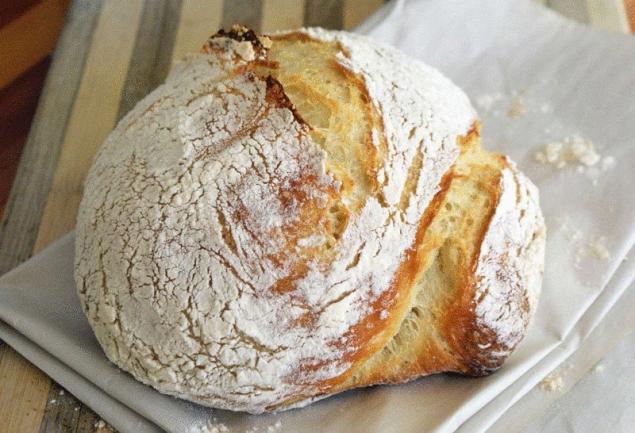
Cooling
Remove the bread from the oven and place it to cool on a wire rack. This is very important, because the moment the bread "will be filled" with oxygen and to release all the moisture. At this point all of the humidity out of the center of a loaf comes to the surface.
Leave the bread to cool for about 2 hours.
Understand that it is difficult, but necessary and important to wait for complete cooling of bread. Cook with love!
P. S. And remember, only by changing their consumption - together we change the world! ©
Source: www.ellamartino.ru/ru/recipes/prostoy-hleb-na-zakvaske-pane-semplice-con-lievito-madre

You will need:
for 3 loaves at 550 g each (basic recipe):
- 900 g of flour from soft wheat type 0
- 100 g whole wheat flour
- 600 g of room temperature water (60% hydration)
- 18 g salt (1.8% of the total weight of the flour)
- 70/80 g leaven for the preparation of starter (see below)
- wooden Board for kneading dough
- harvester with attachments
- bowls
- food film
- wooden spoon
- flour for shaping
- baskets
- pieces of cloth under the basket (read the text)
- a baking stone or baking sheet
- blade
- scraper or knife to cut the dough
- olive oil cold pressed
- potholders

The first feeding
50 g of starter at room temperature
40 g of water (maximum water temperature 35 C)
50 g whole wheat flour
In a bowl put the yeast and add the water. Stir well until a homogeneous mass, add the sifted flour (always her screening, even whole wheat, to avoid lumps in the dough, and that she was saturated with oxygen).
Knead the dough using a wooden spoon or with your hands (as you wish).
Put the dough in a clean bowl, cover it with clingfilm (you can use a measuring Cup) and leave to rise for at room temperature not lower than 22-23 With, until the dough will increase in volume by half (about 5-6 hours).
The second feeding
50 g of the leaven obtained after the first feeding
40 g of water (water temperature about 25 C)
50 g whole wheat flour
In a bowl put the yeast and add the water. Stir well until a homogeneous mass, add the sifted flour.
Knead the dough using a wooden spoon or with your hands (as you wish).
Put the dough in a clean bowl, cover it with cling film (or measuring Cup) and leave to rise for at room temperature not lower than 22-23 With, until the dough will increase in volume twice (about 4 hours).
The third feeding
50 g of the leaven obtained after the second feeding
40 g of water (water temperature about 25 C)
50 g whole wheat flour
In a bowl put the yeast and add the water. Stir well until a homogeneous mass, add the sifted flour.
Knead the dough using a wooden spoon or with your hands (as you wish).
Put the dough in a clean bowl, cover it with cling film (or measuring Cup) and leave to rise for at room temperature not lower than 22-23 With, until the dough will increase in volume twice (approximately 2 hours).
After three feedings, your starter will be strong enough to begin baking bread.
Subsequently, when baking bread, you can instead of flour from soft wheat type 0 to use other types of flour, in the amount of 30-50% and to change the hydration (to increase). Immediately say, that we used 5 types of flour for making this bread.
Keep in mind that the more bread content whole wheat flour, the more water will be required for kneading.
Ideally use a baking stone. But you can also use a regular baking sheet.
Preparation of starter
150 g of flour from soft wheat type 0 (basic recipe)
200 g of water at room temperature of 22-23 C (from main recipe)
70/80 g of the leaven obtained after the third feeding, as described above
First day. Evening, 20.00-21.00
Sift the flour into a separate bowl. In another bowl, put the yeast, pour the water and stir well with a wooden spoon until a homogeneous mass. Add portions of the flour and continue mixing with a wooden spoon. Starter bude sufficiently liquid.
Cover the bowl with the starter with clingfilm and leave to rise for 12 hours at a temperature of 20-21 C.
At higher temperatures the dough grows faster, but not enough will be filled with aromas, that is the bread is not so tasty.
The starter will weigh approximately 400 g.
Kneading dough by mixing the starter with the other ingredients
The second day. Morning 7.00-8.00
On the starter there are a lot of bubbles and a pleasant yeasty aroma. Knead the dough.
750 g of flour from soft wheat type 0 (basic recipe)
100 g whole wheat flour
400 g of water, heated to a temperature of 28-30 C (from main recipe)
18 g of salt
400 g starter
Sift all the flour and divide into two equal parts.
In the bucket combine put the starter, pour in water and stir using the whisk attachment. Using the same attachment, start mixing the dough, portions adding half of the flour.
The second part of the flour add salt and mix. Change in harvester attachment for the whisk attachment hook and continue kneading.
To do this, add portions of the remaining flour (the second half of that mixed with salt).
Continue kneading until a homogeneous, elastic mass, about 15 minutes.
The final dough should have a temperature of 25-26 C.
The first proving
Put the dough obtained in a container (glass is ideal), greased with olive oil cold pressed and wrap well with cling film. Put the dough into the proofing at a temperature of 25-26 C.
Remember that the proofing time depends on many factors: the type of flour, humidity of the flour and the humidity, temperature, hydration, the power of the leaven. Therefore, it is always very approximate. The only thing you can focus is to increase the test.
Therefore, the dough needs to rise twice (about 2.5 hours).
During this proofing get obmenka.The punching is stretching and folding the dough. They make the dough become elastic and rise better during baking.
First obmenka done in 50 minutes.
Turn the dough out onto a work surface lightly sprinkled with flour. Slightly (!) pull one edge of dough and fold it in the middle. Then do the same with the other three edges. That is the principle of the envelope. Salmon ball and put it seam down again to the bowl for further proofing, shook it with cling film.
After 50 minutes, repeat the folding. And wait until the dough has doubled, that is about another 1.5 hours.
The first shaping loaves (boulage)
The ready dough put on a work surface lightly dusted with flour and divide into 3 parts. Form balls and place them on the work surface seam side down.
Pause or rest
Leave the dough to rest on the work surface at room temperature for 30 minutes. Lightly cover it with cling film.
The final shaping of the loaf using baskets
Form the shape of a loaf, given the size of the basket. Pomeroy loaf, gently bend the edges of the dough down well and don't forget to close the seam. Ee lightly sprinkle with flour.
Line a rimmed the bottom of the basket with cling film and then put a wet piece of cloth (thin), the dough was always otavalos slightly damp. Turn the dough seam side up and lightly sprinkle the dough with flour.
More can not touch the dough with your hands, otherwise then it will not rise.
Close the dough with wet cloth and cling film.
Second final proofing
Leave the dough to rise for 1.5-2 hours at a temperature of 24-25 C.
If the oven does not include all three loaves, leave one of them to rise for at a temperature of 12 C. It will be ready for baking after about 3 hours.
How to check if your bread is to baking? Easily tap with your finger in the middle of the dough. If the dough is elastic and will immediately return to its original state, then it is ready. If you will trace from the finger, then you need to wait more. But remember that you should always start the baking before the dough will start to fall off, otherwise, then, in the oven, it is so you won't get up.
Baking bread
Turn the oven (with convection), put it in the middle of the baking sheet or stone on the grill and put down a small bowl filled with boiling water. Preheat the oven to 250 C.
In the oven with steam function, use it.
As soon as the oven reaches 250, remove the hot baking sheet or stone (caution, use oven gloves and potholders), sprinkle it with flour and very gently flip the loaf on a baking sheet. Be careful or one wrong move and everything will fall off.
Make test cuts using a razor blade and immediately place the pan in the oven.
Try to do all this quickly to avoid dropping the test.
Set the oven temperature to 230 C. bake the bread for 30 minutes. After 30 minutes, reduce the temperature to 200-210 C and bake for another 15-20 minutes.
The last 10 minutes, open the oven door and insert into the opening knife, to release steam and has formed a crispy crust.
The total time of bread baking (45-50 minutes).
The bread is ready then when the temperature inside the bread reached 90-95 C.

Cooling
Remove the bread from the oven and place it to cool on a wire rack. This is very important, because the moment the bread "will be filled" with oxygen and to release all the moisture. At this point all of the humidity out of the center of a loaf comes to the surface.
Leave the bread to cool for about 2 hours.
Understand that it is difficult, but necessary and important to wait for complete cooling of bread. Cook with love!
P. S. And remember, only by changing their consumption - together we change the world! ©
Source: www.ellamartino.ru/ru/recipes/prostoy-hleb-na-zakvaske-pane-semplice-con-lievito-madre
Parade of 746 electric vehicles - new world record set in the Netherlands
For life "with the boat on their shoulders"
